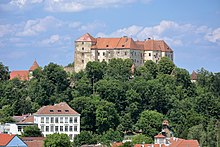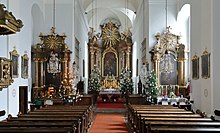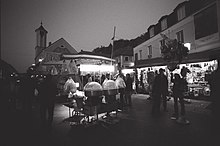Neulengbach
|
Borough Neulengbach
|
||
|---|---|---|
| coat of arms | Austria map | |
|
|
||
| Basic data | ||
| Country: | Austria | |
| State : | Lower Austria | |
| Political District : | Sankt Pölten-Land | |
| License plate : | PL | |
| Surface: | 51.66 km² | |
| Coordinates : | 48 ° 12 ' N , 15 ° 55' E | |
| Height : | 251 m above sea level A. | |
| Residents : | 8,304 (January 1, 2020) | |
| Population density : | 161 inhabitants per km² | |
| Postal code : | 3040 | |
| Area code : | 02772 | |
| Community code : | 3 19 26 | |
| NUTS region | AT123 | |
| UN / LOCODE | AT NEH | |
| Address of the municipal administration: |
Kirchenplatz 82 3040 Neulengbach |
|
| Website: | ||
| politics | ||
| Mayor : | Franz Wohlmuth ( ÖVP ) | |
|
Municipal Council : ( 2020 ) (33 members) |
||
| Location of Neulengbach in the Sankt Pölten-Land district | ||
 The town hall square looking towards the main square |
||
| Source: Municipal data from Statistics Austria | ||
Neulengbach is a town with 8,304 inhabitants (as of January 1, 2020) in the Vienna Woods , which was granted town charter in 2000, in the St. Pölten-Land district in Lower Austria , Austria . It is located 36 km west of Vienna and is a member of the Vienna Woods Initiative Region .
geography
Neulengbach lies on the Laabenbach , which is called Große Tulln from the confluence of the Anzbach . In the municipality of Neulengbach we find the confluences of the Buchenbach (with the Querbachl tributary), Medunabach, Dambach, Haagbach, Seebach and Anzbach . The Raipoltenbach would flow across from Markersdorf, but was diverted early to the Mühlbach (Griesmühle) so that it only flows into the Große Tulln after Habersdorf. The Kirschnerwaldbach flows into the Anzbach in Neulengbach from the right in the Au district . A small part of the municipality of Neulengbach is drained towards the Perschling: The Unterwolfsbach district is located on the Wolfsbach, which flows into the Totzenbach near Kirchstetten . Both drain the southwest part of the Haspelwald. The Totzenbach then takes the Sichelbach on the left and flows north of Böheimkirchen in Michelbach / Perschling . The south-western tip of the municipality (Rothenbucherhöhe / Trainst) is also drained via the Stallbach to Stössingbach / Michelbach / Perschling . The northern end of the municipality is bounded by the Haspelwald . The highest point, however, is the Trainst located in the southwest at 520 m.
geology
From the source to Neulengbach-Haag, the Laabenbach flows through the flysch zone , which consists primarily of sandstones , which alternate with claystones and , more rarely, marlstones , occasionally limestone . This sandstone-rich rock sequence is characteristic of the Vienna Woods. The rocks are practically impermeable to water, so rainwater gets into the river after a short time.
In Neulengbach the river then crosses the very narrow zone of the subalpine molasse . These are conglomerates ( Buchberg , Neulengbacher Schlossberg) and fine-grained sediments , but due to the narrow width of this zone, they do not lead to any noticeable seepage . From Inprugg the Große Tulln flows through the Molasse zone . These are mainly sands , silts and clays (" Schlier "), which are sometimes overlaid by loess . Even these mostly poorly consolidated loose rock are only slightly permeable to water.
From Judenau downstream, the Great Tulln crosses a wide Quaternary gravel area, the Tullnerfeld, to its confluence with the Danube .
On September 15, 1590, the Neulengbach earthquake, one of the worst earthquakes in Austria's history, occurred. The earthquake is estimated to have a magnitude of 5.75 or 6.0 on the Richter scale .
Community structure
The municipality includes the following 43 localities (population in brackets as of January 1, 2020):
- Almersberg (94)
- Anzing (16)
- Au am Anzbach (747)
- Mountain (16)
- Ebersberg (742) including Seebach
- Eitzenberg (6)
- Emmersdorf (149)
- Gamesreith (25)
- Large Vineyard (306)
- Hague near Markersdorf (11)
- Haag near Neulengbach (995) including Frauenhof
- Herbstgraben (8)
- Men's Hub (5)
- Hinterberg (28)
- Inprugg (146)
- Karl Deix Estate (74)
- Small hard (13)
- Kleinraßberg (54)
- Laa an der Tulln (53)
- Langenberg (15)
- Ludmerfeld (90) including Querfeld
- Markersdorf (242)
- Matzelsdorf (66)
- Mosletzberg (18)
- Neulengbach (1526)
- Upper areas (9)
- Oberndorf (37)
- Ollersbach (698)
- Raipoltenbach (318)
- Rothenbucherhöhe (34)
- St. Christophen (363)
- Schoenfeld (457)
- Sword sweeping (9)
- Stick (140)
- Strass (385)
- Theißl (13) (from 2019)
- Trainst (16)
- Umsee (62)
- Unterdambach (112)
- Lower (43)
- Unterwolfsbach (101)
- Weiding (38)
- Wolfersdorf (24)
The towns of Oberdambach (now part of Theißl), Schrabatz and Tausendblum (both came to Schönfeld) were no longer designated as localities in 2019, but Theißl was added.
The community consists of the cadastral communities (date of incorporation) Almersberg, Emmersdorf, Großweinberg, Haag, Inprugg (January 1, 1968), Markersdorf (January 1, 1968), Neulengbach, Ollersbach (January 1, 1971), Pettenau, Raipoltenbach (January 1, 1968) January 1971), St. Christophen (January 1, 1971), Tausendblum (January 1, 1972), Umsee, Unterwolfsbach and Wolfersdorf.
Neighboring municipalities:
- Asperhofen
- Altlengbach
- Maria-Anzbach
- Perschling
- Box near Böheimkirchen
- Neustift-Innermanzing
- Kirchstetten
history
In the 12th century, the Lords of Lengenbach established Neulengbach Castle, a regional center of power. The market in Neulengbach developed around their castle and was given market rights again in 1535 after an older document was lost during the Turkish storm in 1529. Castle mistress Sidonia Palffy successfully defended the castle during the Turkish invasion in 1683, while the market went up in flames. In 1696 the Bartholotti family acquired the castle and the estate. In 1746 the Lubomirsky princes became lords of Neulengbach. From 1823 to 1920 the palace was then owned by the Liechtenstein family. In 1850 the community and the judicial district Neulengbach was established. In 2000 the place received city rights.
Next to the Neulengbach cemetery there is a military cemetery with fallen members of the Wehrmacht and the town's war memorial, as well as a Russian military cemetery with 14 mass and 163 individual graves. These were occupied with dead between April and July 1945.
The renumbering of confusing addresses , which was decided at the beginning of 2018, had to be awaited due to the advance of the National Council election and the municipal council election in early 2020 and was only carried out in the course of 2020.
Population development
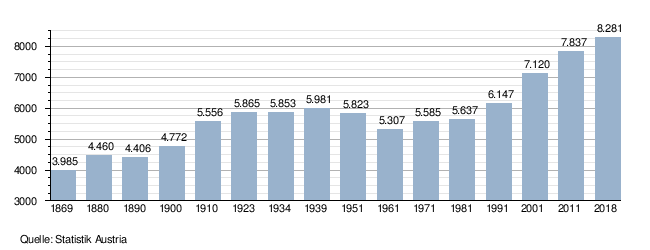
politics
Mayor of the municipality has been Franz Wohlmuth since October 24, 2007, and Leopold Ott is the head of the district.
According to the municipal council election on January 26, 2020, there is the following distribution of mandates in the city council with a total of 33 seats :
ÖVP 15, List of Vice Mayor Alois Heiss (HEISS) 6, Die Grünen 5, SPÖ 5, FPÖ 1, List NEOS 1, others no seats.
Attractions
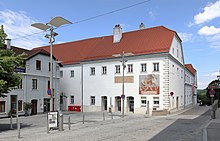
- The courthouse is a three-winged late Renaissance building originally built around 1620 under Freiherr Johann Eusebius Khuen, which was expanded in the middle of the 19th century and in 1951.
- Museum Neulengbach in the courthouse
- The Neulengbach Museum was founded in 1921 as the “District Museum” of Hietzing and the surrounding area and is likely to have gained great importance for the wider area soon after it was founded. Its inventory included, among other things, important prehistoric finds, a hand-painted Bible on parchment paper and the skeleton of a Janissary who fell in the Turkish Wars. At that time, the museum was housed in the meeting room of the old town hall of Neulengbach. How it was conducted during the Second World War is still uncertain. In the first days of April 1945 when fighting broke out between the Soviet Army and the German Wehrmacht in Neulengbach , the museum was looted; most of the objects have been lost these days. As a result, the museum was initially closed. However, targeted collective calls for objects soon started and smaller exhibitions were organized, for which, among other things, models of the most important castles in the area were made. In this way, a presentable collection was gradually brought together, so that the museum could be reopened in 1961, this time under the more modest name “Heimatmuseum”. It was located in the front part of the old courthouse, where it remained open to the public until the mid-1980s, before it had to be closed due to lack of space. This closure also meant a loss of exhibits for the museum, as many lenders took back their pieces.
- On the occasion of Neulengbach's town elevation, the existing holdings were moved to the former offices of the district court. A small study collection was made accessible to visitors under the name "Museum Neulengbach". It can be visited as part of the city tours and was open regularly on Sundays for the first time in 2005 between May and October.
- In 2005 an inventory project was also carried out, in the course of which the entire museum inventory was electronically recorded.
- Egon Schiele was imprisoned in the prisoner's wing of the district court in the same building , as the museum reminds us of.
- The parish church of Neulengbach
- The parish church forms the northern end of the market. It was built between 1623 and 1627 as a Franciscan monastery church. In contrast to the simplicity of the building, the furnishings are very splendid in the Rococo style. In the middle of the high altar is the altarpiece by Kremser Schmidt from 1768.
- Neulengbach Castle ; on a mountain cone, elevated, late Renaissance building from the 16th / 17th century built above the city . century
- Laurenzi Church ; a Romanesque church in the scattered settlement Haag near Markersdorf
- Raipoltenbach ruins ; a ruined castle of which the corner towers are still in ruin
- Baumgarten Castle in Ollersbach
- Wiesenhaus , a late baroque building
- Former branch church of the Holy Trinity on the banks of the Seebach (Umseer Straße 12); a branch of St. Christophen mentioned in a document from 1248 to 1876, later a branch of Neulengbach and since 1982 profaned and privately owned. The church is a small hall with a low western tower and has a Romanesque core. The sacred building was destroyed several times (1683 in the course of the Great Turkish War and in 1805 and 1809 in the course of the Napoleonic Wars ) and rebuilt
- Jewish cemetery in Almersbergstrasse
Sports
- Wienerwaldstadion
- SV Neulengbach
- ÖTB Gymnastics Club Neulengbach 1888
- Neulengbach golf course - Villa Berging
Culture
- Music association Neulengbach-Asperhofen
Regular events
- Reserlmarkt: The so-called 'Reserlmarkt' (derived from the name Theresia ), a fair that takes place every year on the first Tuesday after October 15th ( Teresa of Ávila ), has been very popular for many years . For this purpose, the entire city center will be closed to road traffic and the Neulengbach schools will also close early because of the fair.
- Schielefestival: The Schielefestival has been held since 2000. Here works created by artists on the subject of Egon Schiele are presented.
Economy and Infrastructure
In 2001 there were 365 non-agricultural workplaces, agricultural and forestry operations 146 according to the 1999 survey. According to the 2001 census, the number of people in employment at the place of residence was 3,140. In 2001 the employment rate was 45.99 percent. The headquarters of RWC (two-wheelers) was located in St. Christophen until around 1960 . In 2021, after 64 years, the Rehau works at Neulengbach station are due to close. Mainly plastic pipes were manufactured.
Many companies are organized as members of the Active Economy Neulengbach association. The association was founded in 1984.
schools
traffic
Train:
- The Westbahn runs through Neulengbach. Neulengbach has three stops (Neulengbach Stadt, Neulengbach and Ollersbach).
Street:
- Neulengbach is located on Neulengbacher Straße (B 44) and Tullner Straße (B 19). The Westautobahn (A1), the Außenringautobahn (A21) and Wiener Straße (B 1) are nearby .
Personalities
Honorary citizen
- Martin Wakonig, wholesale merchant from Graz; Elimination of war damage and renovation of Neulengbach Castle
Sons and daughters
- Norbert Mussbacher (1926–2004, born in Ollerbach near Neulengbach), abbot of the Lilienfeld monastery
- Kurt Bergmann (1935–2016, born in Ebersberg near Neulengbach), journalist and politician
- Johann Kurzbauer (* 1943 in Raipoltenbach near Neulengbach), mayor from 1995 to 2007
Personalities who work, worked or died in the place
- Egon Schiele (1890–1918), Austrian expressionist painter , lived in Neulengbach from 1910 to 1912. In 1912 Schiele spent 21 days in custody in Neulengbach Prison. The main charge - alleged seduction of a minor - turned out to be baseless.
- Othmar Skala (1895–1958), important Lower Austrian local researcher
- Fritz Habeck (1916–1997), writer
- Oskar Laske (1874–1951), Austrian architect and painter.
Web links
- 31926 - Neulengbach. Community data, Statistics Austria .
Individual evidence
- ↑ Sonja Burger, Martin Kugler: Hidden Signs for Earthquakes. In: Universum Magazin. Krems-Wien 2016. Issue 11/2016. ZDB ID 2092993-6 . P. 59.
- ↑ Statistics Austria: Population on January 1st, 2020 by locality (area status on January 1st, 2020) , ( CSV )
- ↑ Neulengbach: Election delayed new house numbers orf.at, June 4, 2019, accessed June 5, 2019.
- ↑ Results of the municipal council election 2020 in Neulengbach. Office of the Lower Austrian State Government, January 26, 2020, accessed on February 25, 2020 .
- ↑ Birgit Kindler: Rehau plant in Neulengbach closes at the end of 2021. In: nön.at. Retrieved March 15, 2020 .
- ↑ active: economy. Retrieved on February 26, 2019 (German).




